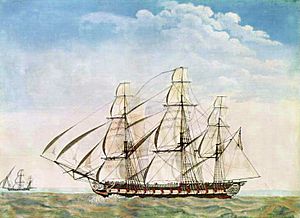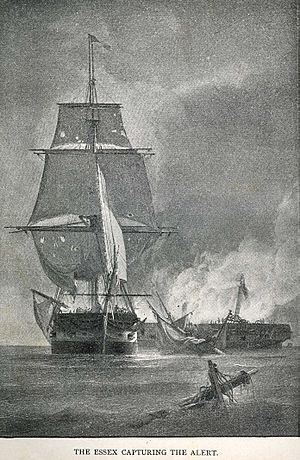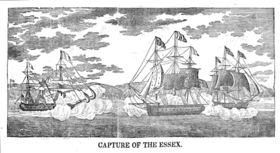USS Essex (1799) facts for kids
 |
|
| History | |
|---|---|
| Name | USS Essex |
| Namesake | Essex County, Massachusetts |
| Builder | Enos Briggs, Salem, Massachusetts |
| Cost | $139,362 |
| Laid down | 1798 |
| Launched | 30 September 1799 |
| Commissioned | 17 December 1799 |
| Captured | 28 March 1814 |
| Name | HMS Essex |
| Acquired | 28 March 1814 |
| Fate | Sold at Public Auction, 6 June 1837 |
| General characteristics | |
| Type | Fifth-rate Frigate |
| Displacement | 850 long tons (864 t) |
| Tons burthen | 89722⁄94(bm) |
| Length |
|
| Beam | 37 ft 3+1⁄2 in (11.4 m) |
| Draft | 12 ft 3 in (3.7 m) |
| Depth of hold | 11 ft 9 in (3.6 m) |
| Propulsion | Sail |
| Sail plan | Full-rigged ship |
| Speed | 11.4 knots (21.1 km/h; 13.1 mph) |
| General characteristics American service | |
| Armament | 40 × 32-pounder carronades + 6 × 12-pounder guns |
| General characteristics British service | |
| Complement | 315 officers and enlisted |
| Armament |
|
| Service record | |
| Commanders: |
|
| Operations: | |
The USS Essex was an important sailing frigate (a type of warship) that belonged to the United States Navy. It had 36 or 32 guns. This ship took part in several big conflicts: the Quasi-War against France, the First Barbary War, and the War of 1812. In 1814, British forces captured the Essex. After that, it became known as HMS Essex and served the British until it was sold in 1837.
Contents
The Ship's Beginning
The Essex was built by Enos Briggs in Salem, Massachusetts. People from Salem and Essex County paid for it, costing about $139,362. The ship was designed by James Hackett.
The Essex was mostly armed with short-range cannons called carronades. These guns could not shoot as far as the 18-pounder and 24-pounder guns on other naval ships. The ship was launched on September 30, 1799. On December 17, 1799, it was officially given to the United States Navy. Captain Edward Preble accepted the ship.
On January 6, 1800, the Essex left Newport, Rhode Island. It was sailing with another ship, the Congress. Their mission was to meet a group of merchant ships coming back from Batavia (now Jakarta, Indonesia).
A few days into the trip, the Congress lost its masts. So, the Essex had to continue alone. It became the first U.S. Navy ship to cross the Equator. It was also the first U.S. warship to sail around the Cape of Good Hope (at the southern tip of Africa) twice in 1800. The Essex successfully finished its mission in November.
Fighting the Barbary Pirates
Captain William Bainbridge took command of the Essex for its second journey. The ship sailed to the Mediterranean Sea with Commodore Richard Dale's squadron. Their job was to protect American trade ships and sailors from attacks by Barbary pirates.
The squadron arrived in Gibraltar on July 1, 1801. For the next year, they escorted American merchant ships. They also blocked Tripolitan (pirate) ships in their ports.
After some repairs in 1802, the Essex went back to the Mediterranean. Captain James Barron was in charge this time. The ship took part in the Battle of Derne on April 27, 1805. It stayed in the area until peace was made in 1806.
In July, the Essex returned to the Washington Navy Yard. It was put "in ordinary," meaning it was taken out of active service. In February 1809, it was brought back into service. It patrolled American waters and made one trip to Europe.
The War of 1812
When the United States declared war on Britain on June 18, 1812, the Essex was commanded by Captain David Porter. The ship had a very successful journey south.
On July 11, near Bermuda, the Essex found seven British transport ships. In the moonlight, it attacked and captured one of them. On August 13, it met and captured the British sloop HMS Alert after a fight. By September, when the Essex returned to New York, it had captured ten enemy ships.
The youngest crew member on the Essex was 10-year-old midshipman David Glasgow Farragut. He later became the first admiral of the U.S. Navy. Farragut was Captain Porter's foster son and stayed with the ship for two years.
The Essex sailed in the South Atlantic and along the coast of Brazil until January 1813. On December 11, 1812, it captured the British mail ship Nocton. The Nocton was returning to England from Rio de Janeiro. The Americans took about £16,000 in money and some of its crew.
Adventures in the Pacific
The Essex then sailed to the Pacific Ocean. There, it caused a lot of trouble for the British whaling fleet. The crew faced tough times with little food and strong storms while sailing around Cape Horn. But the ship safely reached Valparaíso, Chile, on March 14. Along the way, it had captured the whaling schooner Elizabeth and the Peruvian warship Nereyda.
The Nereyda had captured two American whaling ships, Walker and Barclay. But then the British whaler and privateer Nimrod took the Walker. The Nereyda had sent the Barclay to Callao. Captain Porter was able to capture the Barclay before it reached port. He sent the disarmed Nereyda back to the Peruvian authorities as a friendly gesture. He searched for Nimrod and Walker but could not find them. In Valparaíso, the Essex dropped off the crew members it had taken from the Nocton.
Over the next five months, the Essex captured thirteen British whaling ships. One of these was the Essex Junior, which was renamed from Atlantic. This ship then sailed alongside the Essex. Captain Porter put his second-in-command, John Downes, in charge of the Essex Junior.
The two ships and nine of their captured prizes stopped at Nuku Hiva island in the Marquesas Islands on October 25, 1813, for repairs. While they were there, their crews got involved in a local fight. This led to the Nuku Hiva Campaign, which briefly created the first U.S. colony and naval base in the Pacific Ocean. The Essex and Essex Junior left Nuku Hiva in mid-December 1813.
The Final Battle
In January 1814, the Essex sailed into neutral waters at Valparaíso. But it got trapped there for six weeks. The British frigate HMS Phoebe (with 36 guns), led by Captain James Hillyar, and the sloop-of-war HMS Cherub (with 18 guns) were blocking its escape.
On March 28, 1814, Captain Porter decided to try to reach the open sea. He was worried that more British ships would arrive. As the Essex sailed around a point, it lost its main top-mast in bad weather. This made it an easy target. The battle began just north of Valparaíso.
Captain Porter had complained to the U.S. Navy many times. The Essex was armed almost entirely with powerful but short-range 32-pounder carronades. The Phoebe, however, had long 18-pounder guns. This gave the Phoebe a huge advantage because it could shoot from far away.
For two and a half hours, the Phoebe and Cherub fired at the Essex from a distance. The Essex could only fight back with its few long 12-pounder guns. Fires broke out on the Essex twice. About fifty men jumped ship and tried to swim to shore, but only half of them made it. The British rescued sixteen men.
Eventually, Captain Porter had no choice but to surrender. The Essex had 58 crew members dead and 31 missing out of 214. The British lost four men dead and seven wounded on the Phoebe. They had one dead and three wounded on the Cherub.
Lieutenant William Bolton Finch was noted for his brave service on the Essex between 1812 and 1814.
British Service and Later Years
The Essex was well-stocked with supplies for six months. It could easily sail to Europe. So, Captain Hillyar put Lieutenant C. Pearson in command of the ship for the trip to England. Lieutenant Allen Francis Gardiner also helped. The Essex arrived in England in November.
There, the British Admiralty repaired the ship and added it to the Royal Navy as HMS Essex. The Royal Navy never used it for sea battles. Instead, they re-classed it as a 42-gun ship. On July 7, 1819, it served as a troopship, carrying soldiers.
In October 1823, it was turned into a hulk (a ship that can no longer sail) at Cork, Ireland. It served as a prison ship there. From 1824 to 1834, it was a prison ship at Kingstown. On June 6, 1837, the ship was sold at a public auction for £1,230.
In the early 2000s, during work on the east pier of Dún Laoghaire harbor, the Essex's old mooring anchor was found stuck in the pier.
The Essex in Stories
- Herman Melville wrote about the Essex in "Sketch Fifth" of his book The Encantadas. This story focuses on an event near the Galápagos Islands involving a hard-to-catch British ship. It was first published in 1854.
- Patrick O'Brian used the story of the Essex's attacks on British whalers for his novel The Far Side of the World.
- The 1950 American film Tripoli tells a made-up story about the Battle of Derne. The USS Essex is shown in this movie.
Images for kids




